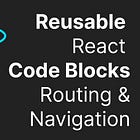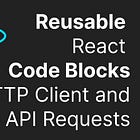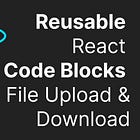Reusable React Code Modules for Super Fast App Development - Part 1
An Overview of Modules to Create for Yourself
Creating reusable code modules in React is essential for building maintainable and scalable front-end applications. This is a series of blog posts that specifically covers each of the following code block in detail, incudling the alternative libraries and options for how you can implement each one of them.
React is a front-end framework used for creating the UI applications on the Internet and mobile devices. As apps have grown more complex over the last two decades, the demand from users has created the need to assess the architectural design of these applications from a number of perspective. For example, routing and navigation that are dynamic and personalized are an essential piece of modern apps. So is the need to present user data and preserve it across multiple sessions. Mant of these features show up repeatedly in apps worldwide which is why we assess modern apps from the lens of the code blocks defined below. Together, they form a rich application experience for your users. It is recommend that you approach the implementation of modern apps from this perspective, utilizing code blocks as modules that can be plug-and-play.
Code Blocks
Introduction
Styling and Components
Routing and Navigation
Authentication and Authorization
Forms and Validation
HTTP Client and Requests to APIs
App State
Offline State
Logging
Analytics and SEO
Web Sockets
File Upload and Download
2. Styling and Components
Objective
Components are the main way that front-end apps represent UI components in today’s world. Components have allowed front-end designs to become much more atomic and well-organized as components can be reusable pieces of software. Components, therefore, are an extension of the HTML skeleton and includes the Javascript interactivity that helps our apps become dynamic and personalized for different users
Styling is then applied onto our components in order to create beautiful user interfaces. You’ll see in Part 2 that there are many different ways to achieve consistent styling in a React app
Key Concepts
Components
Component encapsulation
Dynamic styling
Design theme management
3. Routing and Navigation
Objective
A robust routing system is one of the backbones of any React application. With the use of React Router or the Next framework, we can create dynamic navigation pathways as well as advanced route protection mechanisms.
Key Concepts
Route planning and organization
Route configuration
Nested routes
Route guards
4. Authentication and Authorization
Objective
Authentication and authorization are two key mechanisms that most apps must implement in order to provide protected routes, components and functionality
In React, reusable authentication and authorization logic can be designed using React’s Context API and higher-order components (HOCs)
Key Concepts
User context
Token management
Protected routes
5. Forms and Validation
Objective
It’s also important to provide forms since its the primary method of input for text fields inside web apps
Building reusable form components with validation is beyond the standard React feature-set, so often libraries like Formik and Yup are used
Key Concepts
Form state management
Validation schemas
Error handling
6. HTTP Client and Requests to APIs
Objective
At some point, your application will have to go retrieve data from APIs (backend systems) on remote severs - this is achieved through the HTTP protocol, but we require a mechanism for accessing this protocol
Javascript comes with the fetch library built-in, allowing you to make API calls to a remote URL
More often in React, we use a 3rd party library like Axios.js since it abstracts away certain parts of fetch and makes our implementation cleaner
Axios also allows us to create wrapper classes in order to create reusable API clients for handling HTTP requests, responses, and errors
Key Concepts
Axios instance
Interceptors
Error handling
7. App State
Objective
As you’ll see in React, components come with their own component state that allows you to retain information in-memory.
However, the first issue is that passing component state between components can quickly adding tremendous complexity to our applications - despite React being capable of doing this
With that said, React’s development team did not intend for component state to be passed more than 1-2 layers deep into children components, which is where the first implementation of Context API came in
Context API, Redux and MobX are three systems that make the management of global state very consistent and predictable. In that order, their complexity increases but so does their potential capabilities - having maximal capability with a library like MobX
Key Concepts
State slices
Actions and reducers
Middleware
8. Offline State
Objective
Even with global state management, when a page is refreshed (reloaded), all state is lost - immediately and forever.
Offline capabilities are more common in mobile apps, but ocasionally we’ll have some minimal offline capability for web apps
When this is needed, we can utilize browser standard libraries, like service workers and libraries like Workbox to achieve this
Key Concepts
Service workers
Caching strategies
Syncing data
9. Logging
Objective
Implement logging mechanisms for debugging and monitoring can be done quite simply using libraries like LogRocket
Ocasionally, you’ll want to implement a custom logging solution if you require advanced functionality - that said, most logging libraries are quite powerful with well-defined abstractions for making the addition of logging incredibly simple
Key Concepts
Log levels
Centralized logging
Error tracking
10. Analytics and SEO
Objective
To integrate analytics and SEO, best practices indicate to use Google Analytics or React Helmet, although other options are present
Given that React renders on the client-side, there can be problems with SEO configuration by default
SEO capabilities was one of the primary reasons for the emergence of Next.js, which is an alternative enhancement framework that supports server-side rendering
Key Concepts
Page tracking
Meta tags
Performance monitoring
11. Web Sockets
Objective
Web Sockets are common when building real-time apps
Web Sockets have a standard browser API or 3rd party libraries like Socket.io can also be leveraged
Key Concepts
Socket connection
Event handling
Real-time updates
12. File Upload and Download
Objective
Finally, its hard to escape the development of a web app without having file uploading and downloading capabilities
Although it seems like a separate feature, file uploading and downloading actually goes through a defined API, with one configuration difference of specifying the payload to be a different media type based on the documents that you are moving between client and server
Key Concepts
File input handling
Upload progress
Download management













